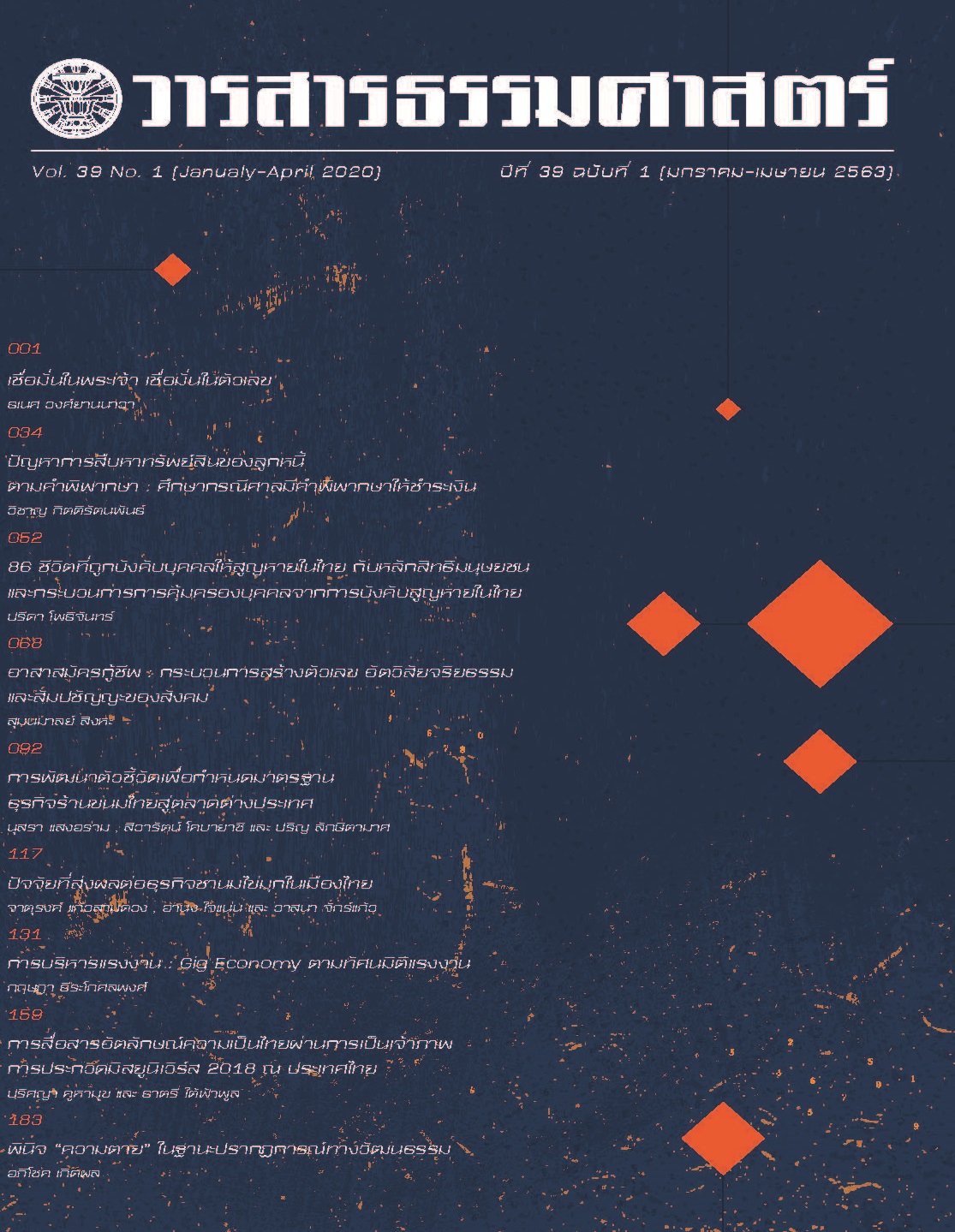The Standard Indicators’ Development of Thai Dessert Shop Business for Foreign Markets
Main Article Content
Abstract
The research aimed to study, (1) developing and checking validity of standard indicators’ Thai dessert shop business for foreign markets and (2) setting the standard indicators’ Thai dessert shop business for foreign markets. The questionnaires were
constructed as a research tool for collecting data from 932 Thai entrepreneurs in dessert shop business and the data was statistically analyzed with frequency distribution, percentage, mean, standard deviation and Confirmatory Factor Analysis: CFA.
The research finding indicated that the specified standard indicators of Thai dessert shops business for foreign markets developed parallel with the empirical data, consisted of 44 indicators from 11 components. Each component had its convergent
validity because the constructed validity valued of 0.60 and weighed component passed over 0.30. As for all specified developed indicators of Thai dessert shops business for foreign markets by total net marks into 5 levels of not passing standard (1 star) (<50%);
below standard (2 stars); (≥50-5 9%) standard (3 stars) (≥60-6 9%); good of standard (4 stars) (≥70-89%) and excellent (5 stars) (≥90-100%).
Article Details
References
กรมพัฒนาธุรกิจการค้า. (2558). คู่มือเกณฑ์มาตรฐานธุรกิจร้านอาหาร ภัตตาคาร. กรุงเทพฯ:กระทรวงพาณิชย์.
กรมพัฒนาฝีมือแรงงาน. (2558). มาตรฐานฝีมือแรงงานแห่งชาติ สาขาผู้ประกอบการอาหารไทย. กรุงเทพฯ: กรมพัฒนาฝีมือแรงงาน.
กระทรวงพาณิชย์. (2557). ธุรกิจร้านอาหาร/ภัตตาคาร. กรุงเทพฯ: กระทรวงพาณิชย์.
กัลยา วานิชย์บัญชา. (2560). การวิเคราะห์สถิติขั้นสูงด้วย SPSS for Windows. (พิมพ์ครั้งที่ 12). กรุงเทพฯ: สามลดา.
โกวิท ไกรศรินท์. (2555). ส่วนประสมการตลาดบริการที่มีผลต่อผู้บริโภคในการเลือกใช้บริการร้านอาหารในอำเภอเมืองราชบุรี. เชียงใหม่: การศึกษาค้นคว้าอิสระปริญญาบริหารธุรกิจมหาบัณฑิต, บัณฑิตวิทยาลัย, มหาวิทยาลัยเชียงใหม่.
ฉัตรศิริ ปิยพิมลสิทธิ์. (2558). ทฤษฎีการวัดและการทดสอบ. สงขลา: คณะศึกษาศาสตร์, มหาวิทยาลัยทักษิณ.
ชวัลรัชต์ ภานุภ์คนันท์, ศิวารัตน์ ณ ปทุม และปริญ ลักษิตามาศ. (2558). การพัฒนาตัวแบบกลยุทธ์การตลาดบริการ เพื่อสร้างคุณค่าการรับรู้อาหารไทยประยุกต์สู่ตลาดอาเซียน. วารสารปัญญาภิวัฒน์, 7(พิเศษ), 26-38
ัยสมพล ขาวประเสริฐ. (2553). การตลาดบริการ. กรุงเทพฯ: ซีเอ็ดยูเคชั่น.
ชูใจ คูหารัตนไชย. (2546). สถิติเบื้องต้น (Introduction to Statistics). กรุงเทพฯ: โรงพิมพ์ มหาวิทยาลัยเทคโนโลยีมหานคร, 7-10.
นงลักษณ์ วิรัชชัย. (2555). ความสัมพันธ์โครงสร้างเชิงเส้น (LISREL): สถิติวิเคราะห์ส าหรับการวิจัยทางสังคมศาสตร์และพฤติกรรมศาสตร์. กรุงเทพฯ: สำนักพิมพ์แห่งจุฬาลงกรณ์มหาวิทยาลัย.
นพรัตน์ บุญเพียรผล. (2560). แนวทางการพัฒนาคุณภาพบริการของธุรกิจร้านอาหารสำหรับนักท่องเที่ยวนานาชาติในเขตอำเภอหัวหิน จังหวัดประจวบคีรีขันธ์. วารสารศิลปากร ฉบับภาษาไทย สาขามนุษยศาสตร์ สังคมศาสตร์ และศิลปะ, 10(1), 61-76.
ประกายรัตน์ สุวรรณ. (2555). การวิจัยและวิเคราะห์ข้อมูลด้วยโปรแกรม SPSS เวอร์ชั่น 20.กรุงเทพฯ: บริษัท วี.พริ้นท์ (1991) จำกัด.
มนตรี พิริยะกุล. (2553). ตัวแบบเส้นทางก าลังสองน้อยที่สุดบางส่วน. การประชุมวิชาการสถิติและสถิติประยุกต์ ครั้งที่ 11 ประจำปี 2553. เชียงใหม่.
วิฑูรย์ สิมะโชคดี. (2552). ISO 9000 คู่มือสู่มาตรฐานคุณภาพระดับโลก. กรุงเทพฯ: ดอกหญ้า.
วีระพงษ์ เฉลิมจิระรัตน์. (2552). คู่มือพัฒนาระบบคุณภาพสู่มาตรฐาน. กรุงเทพฯ: สำนักพิมพ์ผู้จัดการ.
ศรารัตน์ แสนป้อ. (2556). ปัจจัยที่มีผลต่อพฤติกรรมการบริโภคของผู้บริโภคที่ใช้บริการร้านอาหารบนถนนห้วยแก้ว อ าเภอเมืองจังหวัดเชียงใหม่. เชียงใหม่: การศึกษาค้นคว้าอิสระปริญญาบริหารธุรกิจมหาบัณฑิต, บัณฑิตวิทยาลัย, มหาวิทยาลัยเชียงใหม่
สมาคมประชาชาติแห่งเอเชียตะวันออกเฉียงใต้. (2556). แผนยุทธ์ศาสตร์การท่องเที่ยวอาเซียนพ.ศ.2554-2558. ประเทศอินโดนีเซีย: สำนักเลขาธิการอาเซียน
Amaldoss, W., & Jain, S. (2005). Pricing of conspicuous goods: A competitive analysis of social effects. Journal of Marketing Research, 15(2), 18-21.
Barcet, A. (2010). Innovation in services: A new paradigm and innovation model, In Gallouj, F., & Djellal, F. (Eds.), The handbook of Innovation and services (49-67), Cheltenham. UK: Edward Elgar Publishing Limited.
Billingsley, P. (1995). Probability and measure. (3rd ed.). New York: Wiley.
Brian, S. (2011) . Engage!: The comple guide for brands and business to build, cultivate, and measure success in the new web. New York: John Wiley & Sons, 201-202.
Byrne, B.M. (2001). Structural equation modeling with AMOS: Basic concepts, applications, and programming, Hahwah. New Jersey: Lawrence Erlbaum Associates.
Chan, K.W., Yim, C.K., & Lam, S.S.K. (2010). Is customer participation in value creation a double-edged sword? Evidence from professional financial services across cultures. Journal of Marketing, 74(3), 48-64.
Cochran, W.G. (2007). Sampling techniques. (3rd ed.). New York: John Wiley & Sons.
Cronbach, L.J. (2003). Essential of psychology testing. New York: Hanper Collishes.
Evans, J.R., & Lindsay, W.M. (2008) . The management and control of quality.(7th ed.). Ohio: South-Western.
Hair, J. F., Anderson, R.E., Tatham, R.L., & Black, W.C. (2010). Multivariate data analysis. (7th ed.). Upper Saddle River, NJ: Prentice Hall.
Hatcher, L. (1994). A step-by-step approach to using the SAS system for factor analysis and structural equation modeling. Cary, NC: SAS Institute.
Hoogland, J.J., & Boomsma, A. (1998). Robustness studies in covariance structure modeling: An overview and a meta-analysis. Sociological Methods & Research, 26(3), 329-367.
Hsiu-Li, C. (2002). Benchmarking and quality improvement: A quality benchmarking deployment approach. International Journal of Quality & Reliability Management, 19(6), 757-773.
Jackson, P., & Aston, D. (1995). Managing a quality systems using BS/EN/ISO9000. London: Kogan Page Ltd., 101-105.
James, R.L. (1998). Understanding employee motivation, Research and Extension Associate. Ohio: The Ohio State University, 81–85.
Kelloway, E.K. (1998). Using LISREL for structural equation modeling. New Jersey: Sage Publication.
Kline, P. (1994). An easy guide to factor analysis, London and New York. NY: Routledge.
Kotler, P. (2000). Marketing management. New Jersey: Prentice-Hall.
Kotler, P., & Keller, K. (2 0 0 6 ). Marketing and managemen. New Jersey: Pearson Prentice Hall, 50-51.
Kupper, C. (2017). Service innovation - A review of the state of the art, LMU Report 2001-2006, Institute for Innovation Research and Technology Management. Germany: University of Munich.
Lauterborn, B. (1990). New marketing litany; Four Ps passe; C-words take over. Advertising Age, 61(41), 26.
Lovelock, C., & Wirtz, L. (2006). Services marketing. (6th ed.). U.S.A.: Prentice Hall.
Ramasamy, S. (2009). Total quality management. India: Tata McGraw-Hill. Rust, R.T., Ambler, T., Carpenter, G.S., Kumar, V., & Srivastava R. K. (2004). Measuring marketing productivity: Current knowledge and future directions. Journal of Marketing, 68(4), 76-89.
Ryu, H.S., & Lee, J.N. (2012). Identifying service innovation patterns from the service-oriented perspective. PACIS 2012 Proceedings. 60.
Saleh, M.A., Quazi, A., Keating, B., & Gaur, S.S. (2017). Quality and image of banking services: A comparative study of conventional and Islamic banks. International Journal of Bank Marketing, 35(6), 878-902.
Scott, R., & Brand, C. (2001). Emotion marketing. New York: McGraw-Hill.
Silván, M. (1999). A model of adaptation to a distributed learning environment, Pro Gradu Thesis in Education. Department of Education, University ofJyväskylä.
Swink, M., Melnyk, S., Cooper, M.B., & Hartley, J. (2011). Managing operations across supply chain. New York: McGraw-Hill.
Tenner, A.R., & Irving, J.D. (1992). Total quality management: Three steps to continuous improvement. Massachusetts: Addison-Wesley Publishing Company, Inc.
Verma, R., & Boyer, K.K. (2009). Operations and supply chain management: World class theory and practice. United States: South-Western Cengage Learning (International Edition).
Wang, Q., Chris, V., Xiande, Z., & Zhiqiang, W. (2015). Modes of service innovation: A typology. Journal of Industrial Management & Data Systems. 115(7), 1358-1382.

